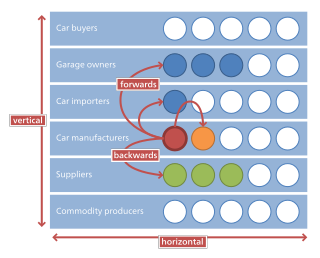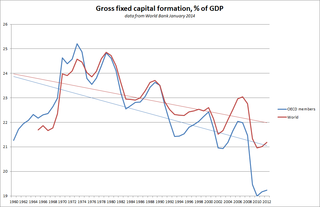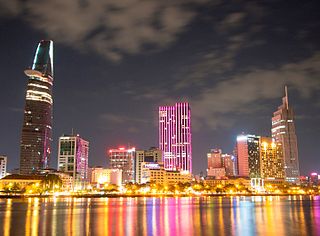
In corporate finance, mergers and acquisitions (M&A) are transactions in which the ownership of companies, other business organizations, or their operating units are transferred or consolidated with other entities. As an aspect of strategic management, M&A can allow enterprises to grow or downsize, and change the nature of their business or competitive position.
A market economy is an economic system in which the decisions regarding investment, production and distribution are guided by the price signals created by the forces of supply and demand. The major characteristic of a market economy is the existence of factor markets that play a dominant role in the allocation of capital and the factors of production.

A conglomerate is a multi-industry company – i.e., a combination of multiple business entities operating in entirely different industries under one corporate group, usually involving a parent company and many subsidiaries. Conglomerates are often large and multinational.

Horizontal integration is the process of a company increasing production of goods or services at the same part of the supply chain. A company may do this via internal expansion, acquisition or merger.

In microeconomics and management, vertical integration is an arrangement in which the supply chain of a company is owned by that company. Usually each member of the supply chain produces a different product or (market-specific) service, and the products combine to satisfy a common need. It is contrasted with horizontal integration, wherein a company produces several items that are related to one another. Vertical integration has also described management styles that bring large portions of the supply chain not only under a common ownership but also into one corporation.

A foreign direct investment (FDI) is an investment in the form of a controlling ownership in a business in one country by an entity based in another country. It is thus distinguished from a foreign portfolio investment by a notion of direct control.

SAP Business One is business management software (ERP) designed for small and medium-sized enterprises, sold by the German company SAP SE. As an ERP solution, it aims to automate key business functions in financials, operations, and human resources.
Organic business growth is related to the growth of natural systems and organisms, societies and economies, as a dynamic organizational process, that for business expansion is marked by increased output, customer base expansion, or new product development, as opposed to mergers and acquisitions, which is inorganic growth.

Gross fixed capital formation (GFCF) is a macroeconomic concept used in official national accounts such as the United Nations System of National Accounts (UNSNA), National Income and Product Accounts (NIPA) and the European System of Accounts (ESA). The concept dates back to the National Bureau of Economic Research (NBER) studies of Simon Kuznets of capital formation in the 1930s, and standard measures for it were adopted in the 1950s. Statistically it measures the value of acquisitions of new or existing fixed assets by the business sector, governments and "pure" households less disposals of fixed assets. GFCF is a component of the expenditure on gross domestic product (GDP), and thus shows something about how much of the new value added in the economy is invested rather than consumed.

Đổi Mới is the name given to the economic reforms initiated in Vietnam in 1986 with the goal of creating a "socialist-oriented market economy". The term đổi mới itself is a general term with wide use in the Vietnamese language. However, the Đổi Mới Policy refers specifically to these reforms that sought to transition Vietnam from a command economy to a socialist-oriented market economy.
Government-business relations are conducted in many ways and through numerous channels in Japan. The most important conduits in the postwar period are the economic ministries: the Ministry of Finance and the Ministry of Economy, Trade and Industry. The Ministry of Finance has operational responsibilities for all fiscal affairs, including the preparation of the national budget. It initiates fiscal policies and, through its indirect control over the Bank of Japan, the central bank, is responsible for monetary policy as well. The Ministry of Finance allocates public investment, formulates tax policies, collectes taxes, and regulates foreign exchange.
International business refers to the trade of goods, services, technology, capital and/or knowledge across national borders and at a global or transnational scale.
The economic history of Brazil covers various economic events and traces the changes in the Brazilian economy over the course of the history of Brazil. Portugal, which first colonized the area in the 16th century, enforced a colonial pact with Brazil, an imperial mercantile policy, which drove development for the subsequent three centuries. Independence was achieved in 1822. Slavery was fully abolished in 1888. Important structural transformations began in the 1930s, when important steps were taken to change Brazil into a modern, industrialized economy.
Business development entails tasks and processes to develop and implement growth opportunities within and between organizations. It is a subset of the fields of business, commerce and organizational theory. Business development is the creation of long-term value for an organization from customers, markets, and relationships. Business development can be taken to mean any activity by either a small or large organization, non-profit or for-profit enterprise which serves the purpose of ‘developing’ the business in some way. In addition, business development activities can be done internally or externally by a business development consultant. External business development can be facilitated through Planning Systems, which are put in place by governments to help small businesses. In addition, reputation building has also proven to help facilitate business development.
Digital economy refers to an economy that is based on digital computing technologies, although we increasingly perceive this as conducting business through markets based on the internet and the World Wide Web. The digital economy is also referred to as the Internet Economy, New Economy, or Web Economy. Increasingly, the digital economy is intertwined with the traditional economy, making a clear delineation harder. It results from billions of everyday online connections among people, businesses, devices, data, and processes. It is based on the interconnectedness of people, organizations, and machines that results from the Internet, mobile technology and the internet of things (IoT).
An economic expansion is an increase in the level of economic activity, and of the goods and services available. It is a period of economic growth as measured by a rise in real GDP. The explanation of fluctuations in aggregate economic activity between economic expansions and contractions is one of the primary concerns of macroeconomics.
Inorganic growth is the rate of growth of business, sales expansion etc. by increasing output and business reach by acquiring new businesses by way of mergers, acquisitions and take-overs. This kind of growth also takes place due to government directives, leading to enhancement of business in some identified priority sector/area. The inorganic growth rate also factors in the impact of foreign exchange movements or performance of other economies.
Trade is a key factor of the economy of China. In the three decades following the Communist takeover in 1949, China's trade institutions developed into a partially modern but somewhat inefficient system. The drive to modernize the economy that began in 1978 required a sharp acceleration in commodity flows and greatly improved efficiency in economic transactions. In the ensuing years economic reforms was adopted by the government to develop a socialist market economy. This type of economy combined central planning with market mechanisms. The changes resulted in the decentralization and expansion of domestic and foreign trade institutions, as well as a greatly enlarged role for free market, s in the distribution of goods, and a prominent role for foreign trade and investment in economic development.
LG Household & Health Care is a major South Korean consumer goods company that manages cosmetics, household goods, and beverages business. It is also the South Korean bottler of the Coca-Cola system.
Following the Arab Spring, the military tightened its control of the Egyptian economy. Details of the military's role in the economy are unclear given that statistics regarding the economy are absent or known to be wildly inaccurate.






